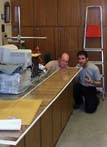
One real problem case was P.Oxy. LV 3804-5: an 'Annual Account of Estate Steward' (3804) dating from the late sixth century, with a less coherent set of 'Estate Accounts' (3805) on the back. The steward's name is Theodorus, and he collected revenues within the rural estates of the wealthy Apion family. Unusually for ancient accounts, his figures are scrupulously accurate, and the document contains some interesting asides on boatbuilding, irrigation works, and oil manufacture.
The problem with this papyrus was always going to be the sheer size of the thing: 288(!) x 30 cm.

"The third and by far the greatest find [of 'archive' mounds], that of the Byzantine archives, took place on March 18th and 19th [1897], and was, I suppose, a 'record' in point of quantity. On the first of these two days we came upon a mound which had a thick layer consisting almost entirely of papyrus rolls. There was room for six pairs of men and boys to be working simultaneously at this storehouse, and the difficulty was to find enough baskets in all Behneseh to contain the papyri. At the end of the day's work no less than thirty-six good-sized baskets were brought in from this place, several of them stuffed with fine rolls three to ten feet long, including some of the largest Greek rolls I have ever seen. As the baskets were required for the next day's work, Mr. Hunt and I started at 9 p.m. after dinner to stow away all the papyri in some empty packing-cases which we fortunately had at hand. The task was only finished at three in the morning, and on the following night we had a repetition of it, for twenty-five more baskets were filled before the place was exhausted.
"This was our last great find of papyri. ..."